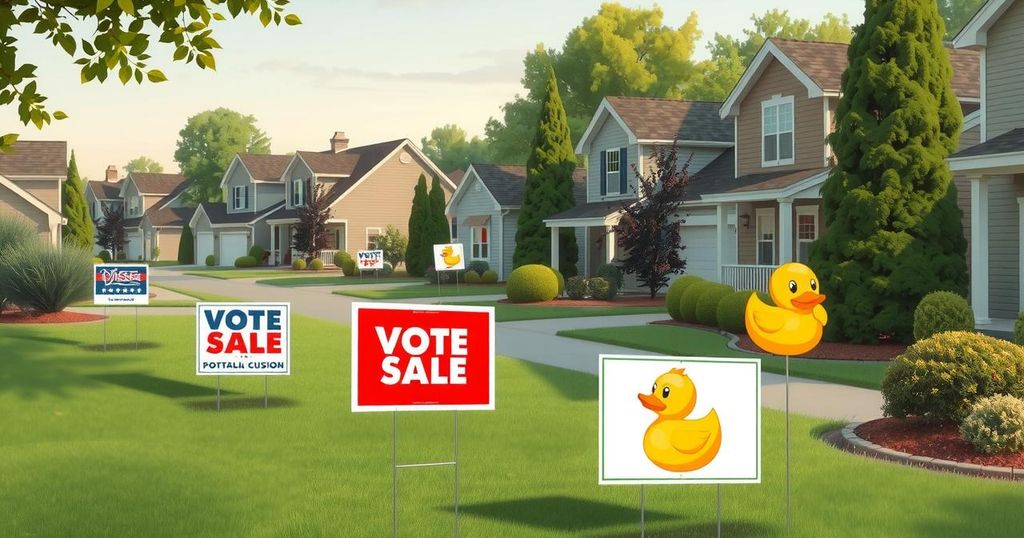America’s Biggest Divide Is the Superpolitical vs. the Exhausted Majority
- The upcoming U.S. presidential election reflects a disengaged electorate.
- The rise of political yard signs shows a fatigue with major party candidates.
- Most Americans feel underrepresented and exhausted by political discourse.
- Researchers identify a large ‘exhausted majority’ seeking moderation.
- The influence of the ‘superpolitical’ class exacerbates existing polarisation.
Diving into the Roots of Political Alienation
The Superpolitical Elite and the Exhausted Majority As we count down to the U.S. presidential election, the streets of Berkeley are claiming a familiar sight: political yard signs. You’d expect the usual abundance of colourful placards advocating for school board candidates and various propositions, but what’s striking—just take a stroll—is the distinct lack of enthusiasm for the presidential candidates. The only surprise came courtesy of ten quirky yellow signs along University Avenue, imploring folks to “Vote for Rubber Ducky, More Quack, Less Whack.” Is it a prank? Maybe. But it undeniably showcases the sheer fatigue many feel when it comes to engaging with the political circus. Recent studies point to this exhaustion as both a crisis and a unique opportunity for political dialogue and change.
The Changing Nature of American Electoral Politics
The Growing Divide Between Polarized Politics and Everyday Americans More in Common, a non-profit organisation, has painted a revealing picture regarding political sentiments across the nation. In its 2018 “Hidden Tribes” report, they unearthed seven distinctive political groups in America. Remarkably, it turns out that five of these groups—accounting for around 67% of the American population—fall into what they term the “exhausted majority.” This bunch is increasingly weary of the left-right tug of war that dominates our political landscape. Researchers behind the findings suggest that while partisans are busy racking up political points, the vast majority of people feel so disillusioned that they’ve taken a step back from the fray, leaving the loudest voices to echo across a currently polarized arena. As Stanford political scientist Morris Fiorina points out, many Americans are too engrossed in the hustle and bustle of daily life—working, raising kids, or simply enjoying leisure time—to make politics a priority. Fiorina has spent half a century dissecting public opinion and argues that it’s not so much a wide divide among average folks, but rather a skewed political system that has turned into a two-party standoff. Each party, he claims, now leans further towards extremes, creating an environment where moderates feel neglected. \nThis phenomenon has alienated a huge segment of the populace that remains frustrated with feeling unrepresented and disillusioned by the ongoing spectacle of partisan politics. Oddly enough, while the parties may be oriented towards extremes, Fiorina suggests that the reality is a political landscape dominated by those on the wings, a small yet vocal minority that wields considerable influence over political discourse. Wings of Superpolitical Influence The “superpolitical” class consists of an estimated 15% of individuals intensively engaged in political activity—campaign donors, social media commentators, and the like. These individuals, Fiorina argues, play a pivotal role in steering both major parties. The reasons behind this disproportionate influence can be traced back to three significant shifts that have crept in alongside increased polarization: a dwindling faith in institutions, a declining sense of belonging, and a rise in echo chambers propagated by social media and 24-hour news cycles. Consequently, a distorted view of American political sentiments emerges where the core ideological distribution has barely wavered since Carter’s presidency in the late 70s. Rather, it’s the manner in which parties organise that has seen a complete overhaul. The Democrats are now largely a homogeneous liberal party whereas the Republicans have entrenched themselves as a solidly conservative entity. This rigidity complicates navigating issues in Congress and festers continued political gridlock. When the election cycle rolls around, it often showcases the disarray within the political framework. The populace find themselves caught between the extremes—wings that neither represents the exhausted majority nor fosters a climate conducive to compromise.
Political Landscapes and The Tired Voter
A System Built on Inequity and Uncertainty Fiorina’s research uncovers how the U.S. electoral scheme has evolved into a period characterised by unprecedented instability. Historically, periods of pronounced electoral control have given way to what many now perceive as a state of unstable majorities. In the simplest terms, politically speaking, we aren’t a 50-50 nation. The reality is closer to a 30-40-30 landscape, creating an electoral environment ripe for confusion and dissatisfaction. Generally speaking, many voters find themselves far removed from the corridors of elite party influences, bumping into frustrations when seeking alignment with a candidate that truly represents their interests. The chilling effect of political overreach, especially as parties strive to cater to their respective bases, only serves to further alienate those in the middle—an area where most voters actually reside. The upcoming elections, Fiorina notes, are shaping up to be less about the electorate and more about satisfying some party elites that could come and go with the winds of public sentiment. Hawkins, his colleague at More in Common, suggests that whilst the pendulum swings towards more progressive candidates like Kamala Harris, there’s an underlying hope of appeal to the moderate centre. As the DNC (Democratic National Committee) speeches have shown, there’s been a notable lack of emphasis on identity politics compared to earlier campaigns, suggesting that perhaps they’re aiming to broaden their appeal beyond a narrow subset of the electorate. The question remains—will this be enough to energise an exhausted majority that has grown weary of extremism in politics? It’s uncertain. But the current climate reflects a profound need for change, urging voters not simply to be tired, but inspired to seek collaborations and solutions.
In summary, America stands at a crossroads where the extreme partisanship of its political system diverges sharply from the sentiments of the exhausted majority. As signs of frustration and fatigue ripple through the electorate, researchers like Fiorina highlight that this disengagement isn’t merely a personal apathy but a systemic issue rooted in the manner politics operates. As the election approaches, the question looms: can candidates navigate these turbulent waters and muster enough support to breach the divide, or will they remain trapped in the riptide of political extremes? The future might just depend on how well they can engage the very voters that feel overlooked.




